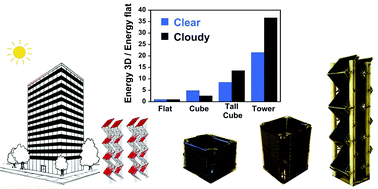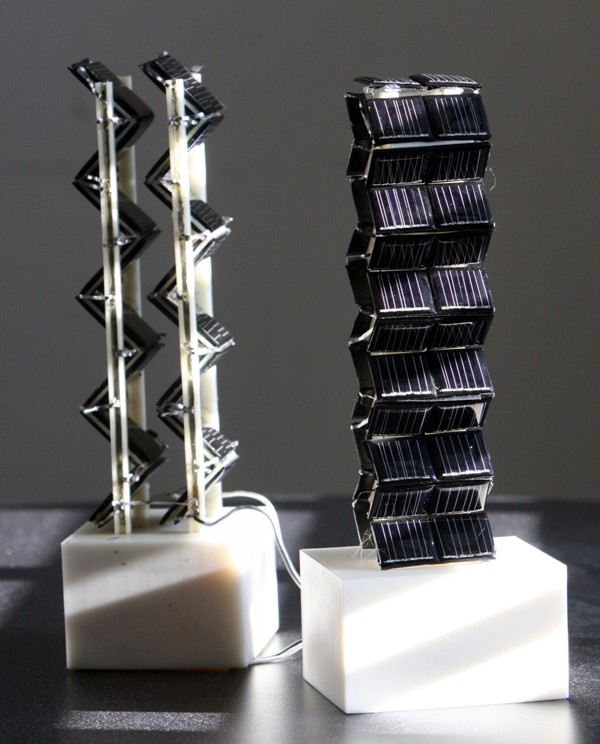
Researchers from the Massachusetts Institute of Technology (MIT) have successfully experimented solar towers that are capable of producing 20 times the energy output of flat solar panels.
The study has been published in the Royal Society of Chemistry. The five researchers wrote in the abstract of the study that they formulated, solved and studied experimentally, the problem of collecting solar energy in three dimensions.
They then discovered that absorbers and reflectors can be combined in the absence of sun tracking, to build three-dimensional photovoltaic (3DPV) structures, which can generate measured energy densities 20 times than stationary flat PV panels. The researchers first tested their work on the MIT laboratory building. They then measured the performance of their invention. The result revealed a major breakthrough in solar energy generation.
According to solar energy experts, most solar panels are placed flat on rooftops, as they are designed to attract the energy from the sun when the sun is directly overhead. The problem, therefore, has been when the angle of the sun rays hitting the panel changes; the panels quickly become less efficient.
In the past, researchers have tried using the Photovoltaic nanoshell structures to trap light for more efficient of solar cells, attempting to solve the weakness of the solar flat panels. However, this current study by the MIT researchers has proven that 3DPV towers are extremely efficient. By using this technique, the solar panels are capable of tracking the movement of the sun, producing extremely large amounts of energy for use.
The researchers built the vertical 3DVP towers in such a way that the panels were able to track the sun more efficiently, while it was close to the horizon. It was also designed to comply with changes in seasons. The 3DPV structures can mitigate some of the variability inherent to solar PV, as they provide a source of solar energy generation at all latitudes.
The towers can double the number of peak power generation hours, and dramatically reduce the seasonal, latitude, and weather variations of solar energy generation, compared to a flat panel design.
The Self-supporting 3D shapes can create new schemes for PV installation; the increased energy density can facilitate the use of cheaper thin film materials in area-limited applications.
The researchers revealed that the tower can be 3D printed, meaning time will not be wasted in case the study is put to large scale production. The design allows people to also build multiple towers next to each other, instead of a singular flat panel.
The 3D printed towers will cost more than flat panels, but experts said the increase in energy output outweighs the cost.
Minds.com reports that the value of this new model is made possible because of the drastic drop in cost of solar panels over the last decade.
Leader of the study, Jeffrey Grossman was quoted as saying “Even 10 years ago, this idea wouldn’t have been economically justified because the modules cost so much, but now, the cost for silicon cells is a fraction of the total cost, a trend that will continue downward in the near future.”
Mr Crossman also added that their findings suggest that harnessing solar energy in three dimensions can open new avenues towards Terawatt-scale energy generation, which will be a milestone achievement regarding energy generation.
You want to support Anonymous Independent & Investigative News? Please, follow us on Twitter: Follow @AnonymousNewsHQ
This article (Sustainable Energy: Scientists Develop Solar Towers that Produce 20 Times the Energy Output of Flat Panels) is a free and open source. You have permission to republish this article under a Creative Commons license with attribution to the author and AnonHQ.com.








I dunno about this ‘finding’. Tracking the sun is fine and makes sense. It is a well-used technique for maximizing solar yield, but it also adds to the cost of an array. By creating a tower of panels, all you are doing is changing the layout of the array from horizontal to vertical, reducing the size of the base footprint, but creating shade lines where none would exist in a horizontal array. According to other articles, the “20 times energy output” is only when compared to the same base footprint, NOT a per panel gain. Restated : put 20 panels in a tower, and you get 20x the solar output of a single panel’s ground cover dimensions. That being said, the advantage of this technique would allow for smaller land use yielding more clean power.
Totally agree!
For higher energy output per used solar-panel, it would be more wise to use reflectors. I think the best design would be 5-flat-solar panel, formed to a cube, inside of a reflector dish. (Kinda the opposite to a lightbulp inside a flashlight with a classic reflector-dish)
I don’t know if I am off in left field here but, is much of the usable energy reflected from the solar panel? if so, the design would allow the second panel to collect this reflected energy as well, this might be part of what they are trying to achieve with this design.
Greedy as we are, the more energy we get, the more energy we will use, and before long thousands of these won’t be enough. And as insignificant it might seem, all the solar energy we trap into these doesn’t reach plants and soil. We need to lower consumption as we develop more efficient production so energy can finally be free at some point.